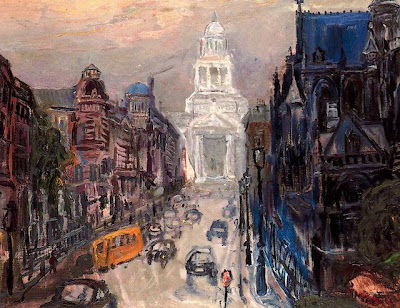Javier Calvo
Javier Calvo has been painting for five decades, since the 1960s, intensifying his pictorial register. At first he worked with a figuration close to Expressionism, and later he turned towards a geometry that allowed him to synthesise his imaginary with the figurative dimension. Expressiveness, Neo-Figuration and Constructivism were far from dogmatic periods, because the decisive thing for this Valencian artist was not so much to “militate” in aesthetic schools as to give free rein to his feelings on the support marked out by the painting. In the early sixties he was interested in painters such as Rouault, Picasso, Chagal and Kandinsky, but also in figures such as Aubrey Beardsley and William Morris. He succeeded in combining a geometrical tendency with a very productive gesturalism, especially in his landscapes. With his usual lucidity, Aguilera Cerni noted that Javier Calvo’s works present models of rationalised behaviour: “Seeking the materialisation of something as impalpable as the pure concept of beauty, he suggests a path of positively corrective intervention in a world where irrationality is thriving and invasive. This excellent young painter seems to tell us that the ferment of artisticity can also be the essence of a human value.” Javier Calvo was associated with Antes del arte and he took part in the important group exhibition Forma y medida en el arte español actual (in the rooms of the Dirección General de Exposiciones, Madrid, 1977), which also included artists such as Alfaro, Amador, Caruncho, Cruz Novillo, José María Iglesias, Labra, Michavila, Rubio Camín, Gerardo Rueda and Sempere. The experience of Constructivism enabled him to develop a sense of order and symmetry, and he painted several works that had points of contact with Yturralde’s “impossible figures”.
Calvo clearly did not wish to remain trapped in geometrical forms and he needed to introduce references to emotional places. The stylistic quality of the landscape that he has developed, with origins in Romanticism, touches on truly original ideas. The decisive feature is his obsession with capturing the force and intensity of natural phenomena, but what he wants most of all is to retain the vital presence of painting. In the Malvarrosa series (1977–79), Javier Calvo attempts a poetic recovery of childhood, using a new kind of figuration and achieving a humanisation of his language when compared to his previous abstract vocabulary. These works are images for the memory that transmit profound nostalgia, combined – as always – with the pleasure of painting. His retrospective emotions are counterbalanced by a certain tone of serenity.
The series on glamour and fashion, a field for which Javier Calvo has a tremendous weakness, is undoubtedly the one that has enabled him to offer his most mature syncretic ideas. Javier Calvo’s relationship with the “empire of fashion” is wide-ranging, in his practice as an artist and as a teacher. One of the first and most important examples is the Glamourosas series that he presented at La Gallera in 1995. “The way in which he makes clothes the main feature,” as Mara Calabuig says, “without ties or obligations, yet keeping well away from a merely documentary temptation, is a great artistic revelation in this unusual exhibition. Javier Calvo deliberately erases faces and ignores anatomies, disclosing fashion in its full force, its constructive quality, which he underlines by achieving unexpected effects of mobile architecture that have complete autonomy and a penetrating power of suggestion.” His discoveries of texture, composition and gesture have expanded from the time of the Glamourosas series to the paintings that he is presenting at the IVAM. He has expanded his reflection on the pose, with all the sense of theatricality that it entails, situated somewhere between stillness and excess, between delicacy and gentleness and striking solemnity. His paintings render a meticulous tribute to the great photographers and designers who devoted their imagination to this world of material and folds, beautiful bodies and fascinating presences. Fashion, uniting the ephemeral and the eternal, the very pulse of modernity, reappears in the museum to seduce us in its subtlest way.








.jpg)

.jpg)
































































ليست هناك تعليقات:
إرسال تعليق